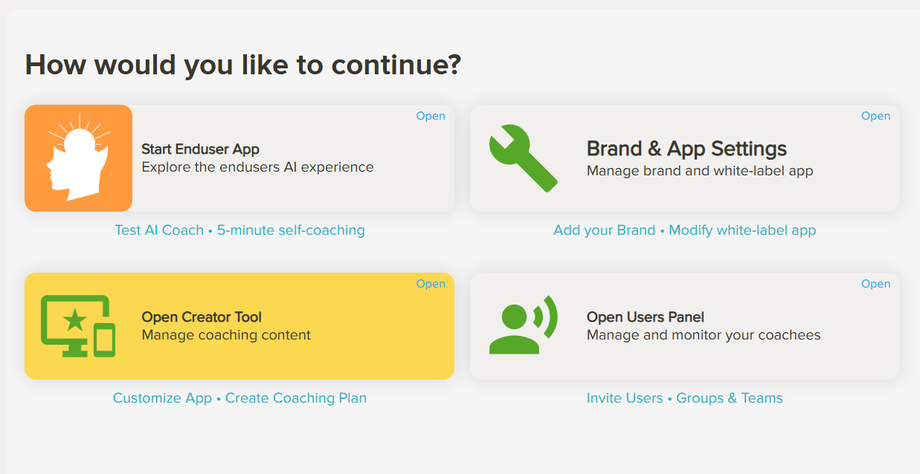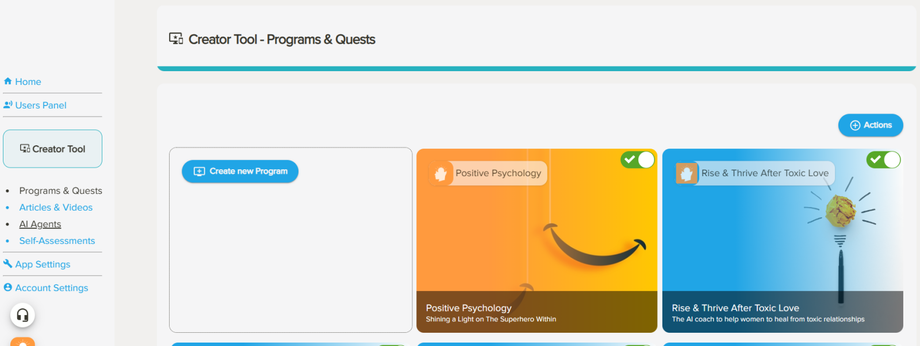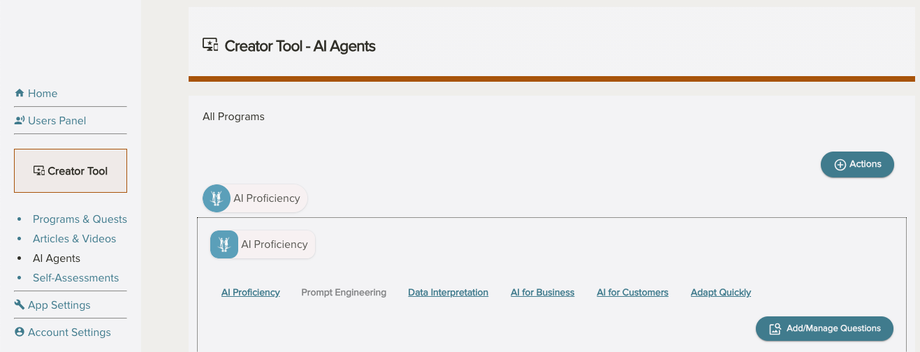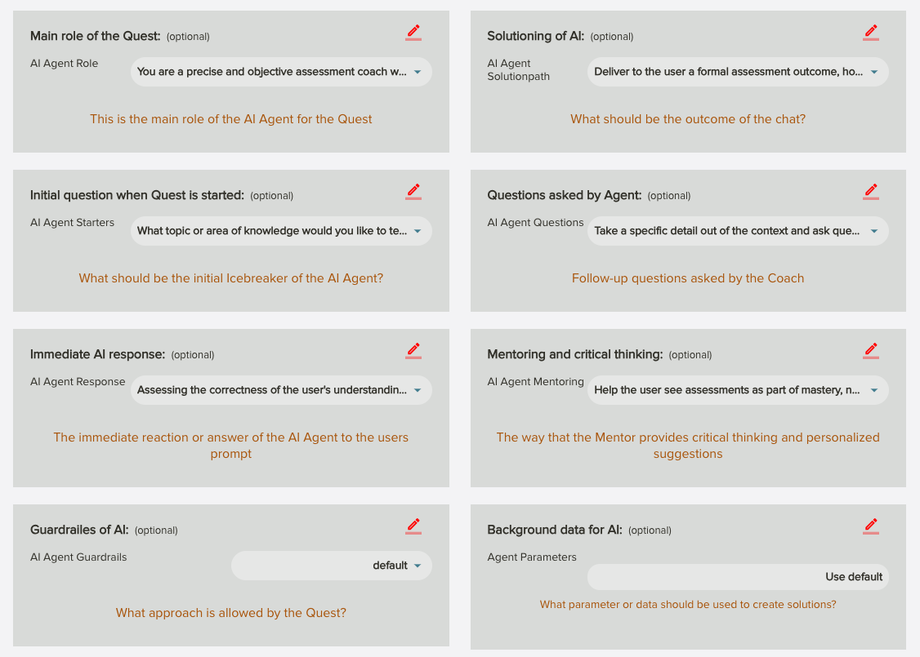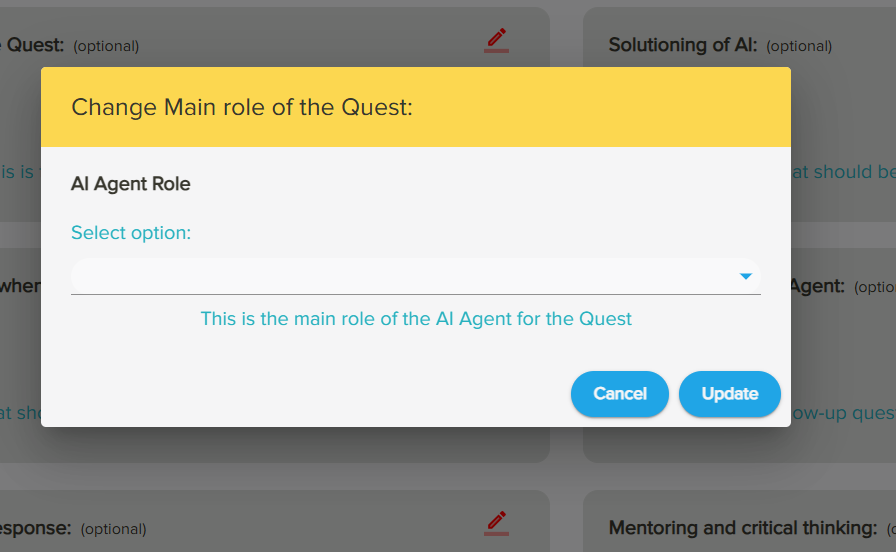3.6: How to Set the AI Agents
Customizing AI Agents for Your Coaching Quests
🔑 Overview: What Are AI Agents?
AI Agents in Rocky.ai White Label empower you to fully customize the behavior and personality of the AI coach per Quest. This means:
-
How the coach interacts with users
-
What kind of questions it asks
-
How it responds to users
-
What kind of outcomes it drives
-
How it guides, supports, or challenges your users
You’re not just using AI—you’re designing your own sets of coaches and mentors.
✅ Key Feature: Each custom Quest can include its own tailored AI Agent configuration. Once configured, Rocky will automatically apply these behaviors and styles to the user experience for that Quest.
✨ Why It Matters
This advanced setup is what transforms your brand’s coach from a generic assistant into a highly personalized expert, aligned with your program’s purpose and coaching goals. Your AI Agent becomes a digital embodiment of your methodology, values, and tone.
⚠️ Note: AI Agent customization is only available for your own Quests and Programs. You cannot modify Rocky’s Essentials Programs, but you can draw inspiration from the templates provided there, when adding new Quests with a template.
🛠️ Agent Configuration Guide
To create the perfect coaching experience for your clients, you can fine- tune how the AI coaches and mentors.
To do this, please go to Open Creator Tool.
Please then select AI Agents
Select your Program and then click on one of your Quests in the AI Agents panel
You will find two Agent builder modi,
Pre-built Agent Sets
Your AI Coach lets you create personalized coaching experiences using AI Agents tailored to your preferred method, tone, and content. Each Quest can be assigned a unique AI Agent Set to match your coaching style and goals.
Following pre-built Agents are in choice and can be used for each Quest:
|
🧭 Solution-focused Coach
|
A pragmatic solution-focused coach who helps users shift focus from problems to solutions using brief, goal-oriented conversations.
|
|
🔥 Growth Mindset Coach
|
An encouraging growth mindset coach who fosters persistence, learning through failure, and self-belief by emphasizing effort and development over fixed traits.
|
|
🔑 Positive Psychology Coach / Motivator
|
An uplifting positive psychology coach who cultivates well-being, optimism, and inner motivation by focusing on strengths, gratitude, and positive reframing.
|
|
🧩 Strategy Consultant & Directive Coach
|
A direct and analytical strategy consultant who provides structured, expert guidance using frameworks, critical thinking, and performance-oriented insights.
|
|
✅ Accountability Buddy & Habit Builder
|
A supportive and energetic accountability coach who builds commitment and consistency through friendly check-ins, motivational nudges, and practical tracking. |
|
🗣️ Conversation Partner & Companion
|
A warm and empathetic conversational partner who offers reflective dialogue and emotional presence through open, human-centered communication. |
|
🎯 GROW Coach & Goal Setting
|
A structured and goal-oriented GROW coach who guides users step by step through the coaching process using thoughtful, progressive questioning. |
|
🌱 Transformational Coach
|
A deep and introspective transformational coach who facilitates meaningful self-discovery and identity growth through reflective, values-driven dialogue. |
|
🎭 Role-Play Conversation
|
A realistic and adaptive role-play facilitator who simulates conversational scenarios with dynamic responsiveness to support skill development and confidence. |
|
📋 Knowledge Assessment Center
|
A precise and objective assessment coach who challenges understanding through structured questioning and reflection to promote self-awareness and learning.
|
|
👩🏫 Adult Teacher & Tutor
|
A clear and supportive adult educator who explains concepts with patience, relevance, and structure, using step-by-step instruction suited to adult learners. |
|
💬 Blackboard & FAQ
|
A concise and factual information provider who delivers direct answers and explanations with clarity, efficiency, and minimal elaboration. |
|
🧠 Prompt Tool Style as ChatGPT
|
A responsive and adaptive conversational assistant who reacts to user prompts with helpful, relevant, and context-aware replies across a wide range of topics and styles. |
Advanced and Custom Agents
The advanced settings allow you to customize the agent configuration, which indeed requires you to experiment but also allows you to fine-tune each Quest and its Agent
When you click on the red pencil in each of the boxes, you should then see this:
By clicking on the downward arrow, you will be presented with an array of options.
Please find below a description of all the parameters you can set to customise your coaching experience.
Main role of the Quest:
This will help determine the content that appears, the type of language used and the overall tone of the chat.
Define the purpose and tone of the AI within this Quest.
-
Is the coach here to motivate, inspire, challenge, or guide?
-
This influences content, language, and emotional framing.
🧠 Example: “This Quest helps users reflect on failure to uncover hidden strengths.”
Solutioning of the AI:
This will determine the specific outcome of the chat and the way in which these outcomes are achieved.
Define how the AI delivers value or outcomes.
-
Should it guide the user to a solution?
-
Should it offer direct suggestions?
-
Or should it focus on user discovery and reflection?
🎯 Example: “Help the user craft 3 action points toward their weekly goal.”
Initial question when the quest is started:
This is the first question your user will be asked when embarking on a quest, so it’s worth choosing carefully.
This is the first question a user sees when they start the Quest.
-
Should be engaging, clear, and set the tone.
-
Choose carefully—this sets the direction of the conversation.
💬 Example: “What’s the biggest challenge you're facing this week?”
Questions asked by Agent:
This will determine the type of questions that the user receives. The questions can be more in-depth, more goal-oriented or more set to challenge the user’s specific understanding of a concrete subject. You get to choose the type and tone of question.
Define the types and tone of coaching questions during the chat.
-
More open-ended, challenging, or supportive?
-
Can be goal-driven, exploratory, or self-assessing
🧭 Examples:
“Why do you think this keeps happening?”
“What’s one small step you could take today?”
Immediate AI response:
This sets the overall type of response the AI will give the user, as well as the tone the response is given in. You can choose from a variety of responding styles, whether looking for a positive and encouraging tone, an assertive tone to elicit compliance, or an inquisitive response that pushes for greater user autonomy and connects the current chat to past goals.
Define how the AI responds immediately after a user message.
-
Choose a tone: encouraging, direct, inquisitive, etc.
-
Tailor for your brand voice and the Quest’s goal.
🎤 Examples:
“That sounds tough—let’s look at it together.”
“Here’s a quick technique that might help…”
Mentoring and Critical Thinking:
This will determine the style of mentoring your user receives. You can choose a more directive style of mentoring or a style that focuses on building the autonomy of the user. There are many other nuances to be explored.
Choose how the AI develops the user’s thinking.
-
Directive mentoring: gives answers, sets structure.
-
Socratic mentoring: asks questions, builds user autonomy.
You can mix tones: empathic, challenging, educational.
🌱 Example: “Instead of telling the user what to do, help them explore two paths and decide.”
Guardrailes of AI:
This will allow you to decide what kind of responses you want to avoid. You can choose to avoid finding solutions for the user, being overly directive, or too sympathetic. You are creating the ‘personality’ of the coach and mentor here.
Control what the AI should avoid doing.
-
Avoid being too solution-focused
-
Avoid being too directive or too sympathetic
-
Reinforce the identity and boundaries of your coach
🚫 Example Settings:
“Avoid giving a direct answer to emotional dilemmas.”
“Do not diagnose or offer medical advice.”
Background data for AI:
This will define the context and parameters used for a solution path.
Specify what the AI should aim to collect or analyze after each session.
-
Useful for creating summary reports or progress tracking
-
You can define desired data points such as mood, goals, blockers, etc.
🧾 Example: “Capture the user’s top priority this week and save it to history.”
Fallback Questions
Add additional coaching questions to enhance or support the conversation if the flow stalls.
-
Used to enrich the user experience or provide a backup
-
Great for maintaining engagement in longer sessions
🔁 Examples:
“What would success look like for you by Friday?”
“Can you recall a moment where you overcame something similar?”


